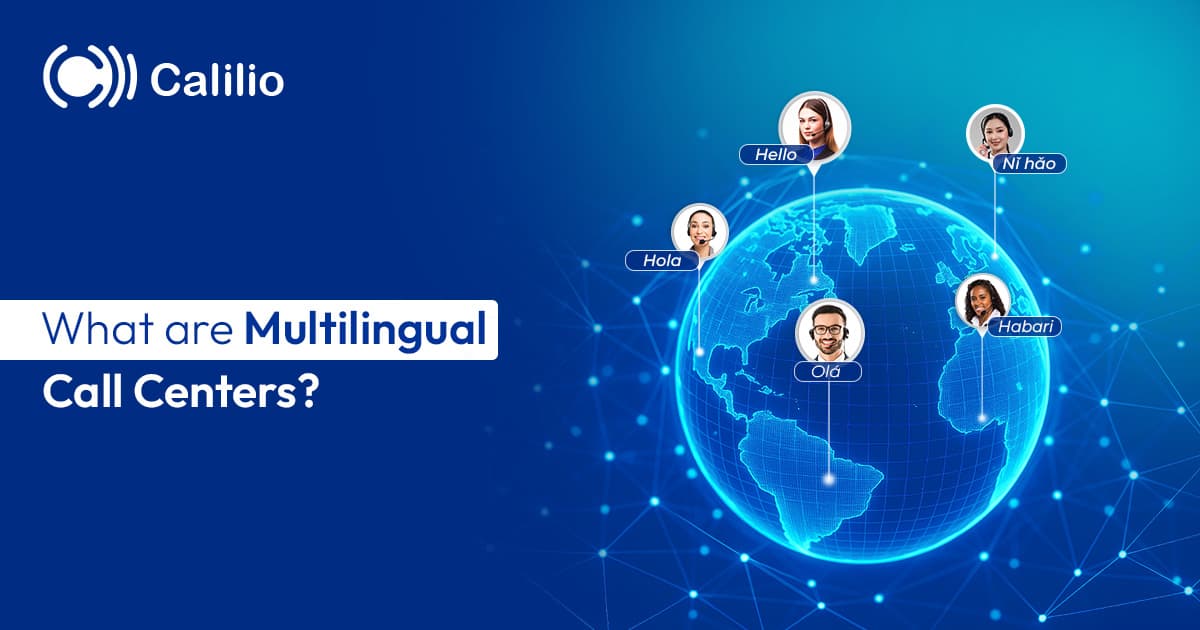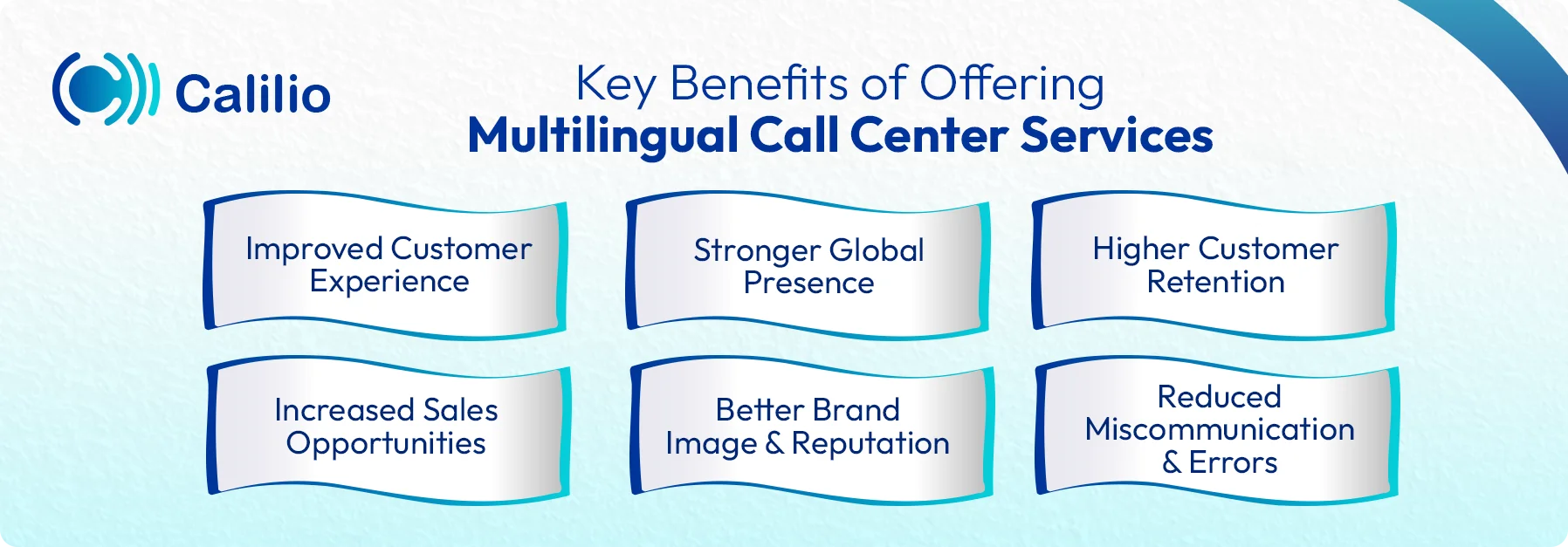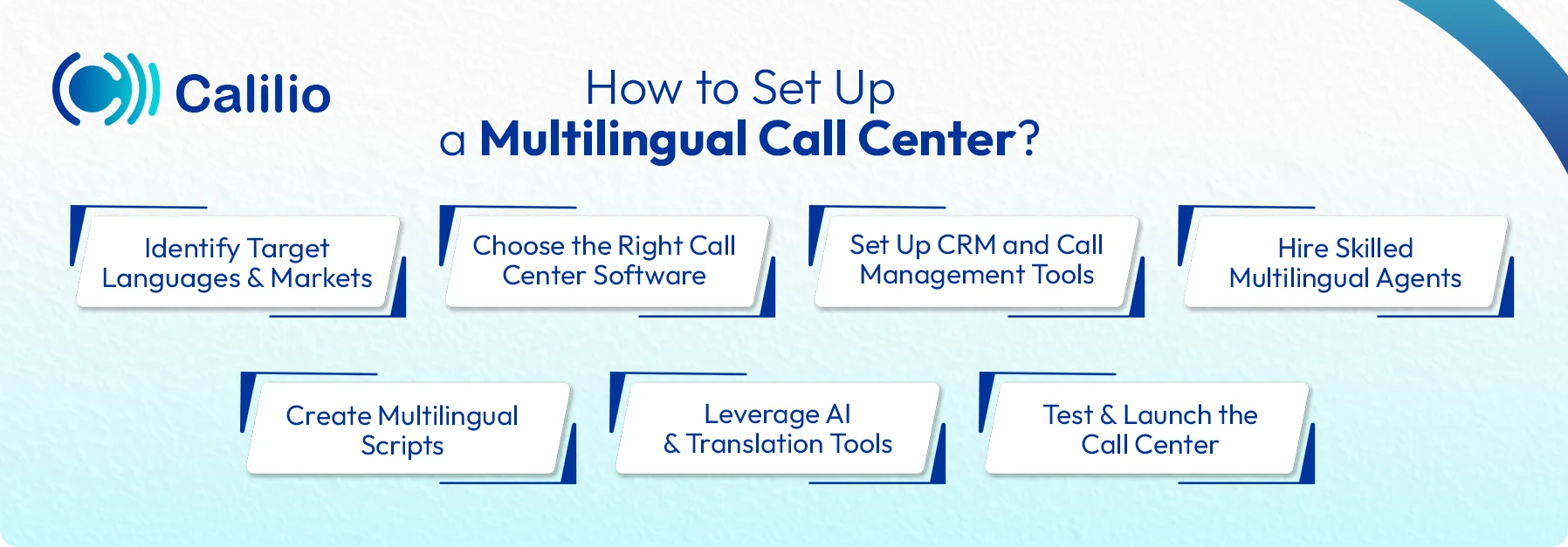Multilingual Call Centers Explained: Benefits, Features & Setup Tips

Running a call center means serving customers from different regions. When agents speak only one language, communication gaps can easily arise. Customers may struggle to explain their issues or understand responses, leading to frustration, poor reviews, and even lost sales.
A multilingual call center removes these barriers by offering support in multiple languages through skilled agents and intelligent automation. It allows your team to handle calls, chats, and emails for global audiences with ease. This ensures clear communication, faster resolutions, and a better customer experience.
In this guide, we’ll explain what multilingual call centers are, how they work, their key benefits, essential features, and best practices to build and manage one effectively.
Key Highlights:
A multilingual call center helps businesses communicate with global customers in their native languages, improving understanding and satisfaction.
It operates using language-based routing, AI translation, CRM integration, and skilled agents to deliver seamless multi-language customer service.
Businesses can reach customers on a global level, strengthen customer relationships, and improve loyalty by providing effective multilingual customer care.
To set up a multilingual call center, identify target languages, choose cloud-based software, hire multilingual agents, integrate CRM tools, and use AI.
Managing multilingual customer support involves challenges such as finding skilled agents, maintaining consistency, and addressing cultural and translation issues.
Regular training, use of AI tools, and quality monitoring help maintain consistency and efficiency across all supported languages.
What are Multilingual Call Centers?
A multilingual call center is a customer service hub where agents handle calls, messages, and chats in multiple languages. It allows businesses to communicate with customers from different regions in their native language, eliminating language barriers.
Multilingual call centers employ agents fluent in diverse languages or use AI-powered translation tools to bridge communication gaps. These centers provide multilingual customer support through phone, email, live chat, or social media, ensuring customers get the help they need in the language they understand best.
Key Benefits of Offering Multilingual Call Center Services
A multilingual call center helps businesses deliver personalized support in clients’ native languages, improving customer satisfaction and loyalty. It also expands global reach, boosts sales, and strengthens brand reputation.

- Improved Customer Experience: Customers feel more comfortable when agents speak their native language, leading to better satisfaction.
- Stronger Global Presence: Businesses offering multilingual customer support can easily reach international markets and build local connections.
- Higher Customer Retention: Clear communication through multilingual customer care increases satisfaction and keeps customers loyal to the brand.
- Increased Sales Opportunities: With multi-language customer service, sales teams can engage potential clients in their native language, improving conversion rates.
- Better Brand Image and Reputation: Offering multilingual call center services shows cultural inclusivity and positions the business as a global brand.
- Reduced Miscommunication and Errors: Speaking the customer’s language minimizes confusion, leading to more accurate and faster issue resolution.
Essential Features of an Effective Multilingual Call Center
An effective multilingual call center uses language-based routing, real-time translation, CRM integration, and omnichannel tools to connect customers with the right agents quickly. It leverages AI, call analytics, and automation to deliver faster, more personalized multilingual customer support.
I. Language-Based Call Routing
Advanced routing automatically directs customers to agents who speak their preferred language. It helps reduce waiting time and ensures every caller connects with the right representative immediately.
II. Real-Time Translation and Transcription
Many multilingual call center services use AI-based tools for instant call transcription and translation. This helps agents communicate accurately even if they’re not fluent in a customer’s native language.
III. Interactive Voice Response (IVR)
A multilingual IVR system lets customers choose their preferred language through menu options. It simplifies the process and helps manage large call volumes effectively.
IV. Omnichannel Support
An omnichannel contact center with multilingual customer service lets customers reach support through calls, chats, emails, or social media in their own language. It keeps communication smooth and consistent across all channels, improving overall customer satisfaction.
V. Call Recording and Analytics
Recording multilingual interactions helps monitor service quality and train agents. Analytics tools further evaluate customer satisfaction and identify areas for improvement.
VI. AI-powered Assistance
Intelligent automation tools such as chatbots and sentiment analysis enhance response speed and accuracy. They support human agents in delivering efficient multi-language customer service around the clock.
How to Set Up a Multilingual Call Center?
To set up a multilingual call center, identify target languages, choose reliable cloud-based software, and integrate CRM for personalized support. Then, hire skilled agents, create a multilingual script and test the system before launch.

1. Identify Target Languages and Markets
Start by analyzing your customer base to identify which languages are most needed. Focus on regions where your business operates or plans to expand, and select languages that will provide the best customer coverage.
2. Choose the Right Call Center Software
Invest in a cloud-based platform that supports multilingual call center services, including features like IVR, call routing, analytics, and CRM integration. The system should also enable agents to work from anywhere, ensuring flexibility and global accessibility.
3. Set Up CRM and Call Management Tools
Connect your call center with CRM software to store customer data, call history, and language preferences. This integration enables personalized multilingual customer support and faster resolutions.
4. Hire Skilled Multilingual Agents
Hire agents who speak multiple languages and understand local cultures. Good communication and cultural awareness help them deliver multilingual customer care that feels genuine and easy to understand.
5. Create Multilingual Scripts
Develop clear and culturally appropriate call scripts, FAQs, and documentation in multiple languages. Well-written materials help agents maintain accuracy, consistency, and professionalism during interactions.
6. Leverage AI and Translation Tools
Implement AI-powered tools that assist with real-time translation, transcription, and sentiment analysis. These technologies enhance communication speed and quality, especially in complex or technical conversations.
7. Test and Launch the Call Center
Before going live, test the system in a few regions or languages. Check performance, fix any issues, and make improvements. After successful testing, launch your multilingual call center to serve customers confidently worldwide.
Challenges in Managing Multilingual Customer Support
Managing multilingual customer support comes with challenges like recruiting skilled agents, maintaining message consistency, and ensuring cultural sensitivity across languages. It also involves higher costs and possible translation errors.
- Recruiting Skilled Multilingual Agents: It can be difficult and costly to find qualified agents fluent in multiple languages, especially for less common ones.
- Maintaining Consistency Across Languages: Ensuring uniform tone, message, and service quality in every language requires strict communication guidelines and regular training.
- Ensuring Cultural and Regional Sensitivity: Agents must understand cultural differences to communicate respectfully and avoid misunderstandings.
- Translation and Communication Errors: Even with AI or translation software, certain phrases or technical terms can be misunderstood. Even a small error can lead to confusion or dissatisfaction.
- Higher Operational Costs: Hiring multilingual staff, providing training, and managing additional tools increase operational expenses.
Best Practices for Implementing Multilingual Call Centers
To run successful multilingual call centers, focus on training agents, use AI tools wisely, and track key metrics by language. Also, regular updates to scripts and knowledge bases ensure accurate and efficient multi language customer service.

- Train Agents Regularly: Conduct frequent language and product training to help agents communicate clearly and confidently in every supported language.
- Maintain Cultural Awareness: Encourage agents to understand local customs and etiquette to ensure respectful and culturally sensitive multilingual customer care.
- Use AI and Automation Wisely: Use AI for translation, transcription, and call routing to boost accuracy and speed.
- Standardize Quality Across Languages: Set clear communication guidelines to maintain consistent tone, accuracy, and service quality across all languages.
- Monitor Key Metrics by Language: Track call center metrics like response time, resolution rate, and satisfaction for each language to ensure balanced service quality.
- Offer Omnichannel Support: Provide multi-language customer service through calls, chats, emails, and social media for a unified experience.
- Gather Customer Feedback: Collect multilingual feedback to measure satisfaction and identify areas for improvement in multilingual customer support.
- Keep Knowledge Resources Updated: Regularly update call scripts, FAQs, and knowledge bases in all supported languages to keep information accurate and consistent.
Conclusion
A multilingual call center is essential for businesses that serve customers across different languages and regions. It builds trust, improves communication, and enhances the customer experience by providing support in their preferred language. With the right technology, trained agents, and AI-powered tools, businesses can deliver reliable and consistent multilingual customer support while maintaining quality and efficiency.
No Tricks, Just Treats
Use Code CALILIOWEEN25 & Get A Spooktacular 10% Off Your Calilio Subscription. Start Your Savings Now!
Wicked Savings Of 10% Off With Code CALILIOWEEN25
Frightfully Affordable Virtual Numbers From - Just $2/month
The Most Hauntingly Affordable VoIP for Businesses
Powered by AI magic That’ll Cast A Spell On Your Calls


Frequently Asked Questions
Which languages are most in demand for multilingual call center services?
The most in-demand languages for multilingual call center services include English, Spanish, French, German, Mandarin, and Arabic, as they cover the largest global customer bases.
Should I outsource or build my own multilingual call center in-house?
Can small businesses afford multilingual call center services, or is it only for large enterprises?
What cultural considerations must be addressed in multilingual customer support?

Still have questions?
Can’t find the answer you’re looking for? Please chat with our friendly team.
Stay in the loop
Get the latest call insights, trends, and updates delivered straight to your inbox.
By subscribing, you agree to receive updates from Calilio.
You can unsubscribe anytime.
